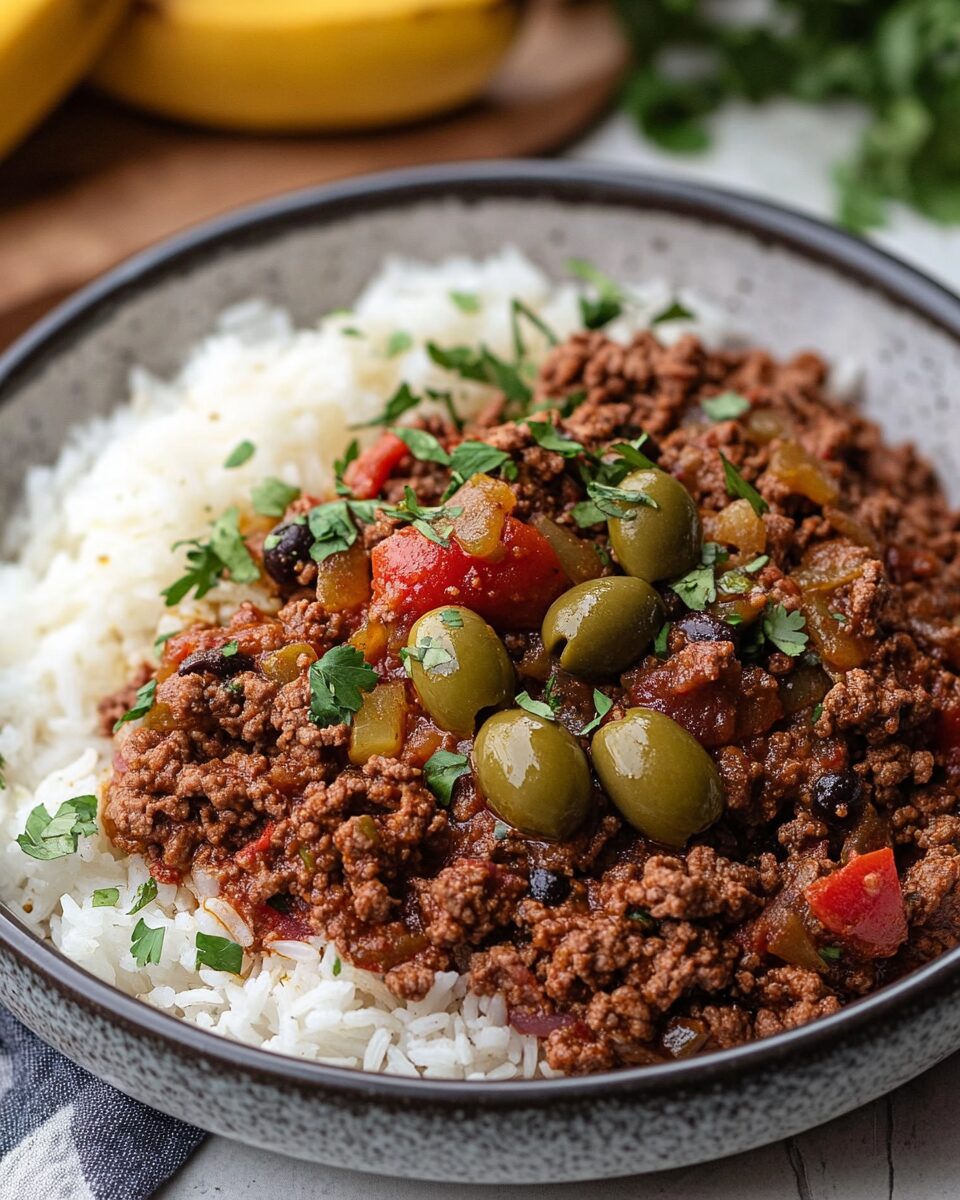The Cuban Beef Picadillo is a classic comfort dish rooted in rich culinary tradition. Combining ground beef with briny olives, sweet raisins, and aromatic spices, it creates a complex flavor profile that is uniquely satisfying. Whether served over white rice, with a side of plantains, or tucked into empanadas, it delivers bold flavor with every bite. This dish is not only hearty and delicious but also incredibly versatile. It comes together in one pan, making it a fantastic weeknight dinner solution. With pantry staples and a few fresh ingredients, you’ll have a meal that tastes like it’s been simmering for hours. Perfect for busy families or anyone looking to explore Cuban cuisine from the comfort of their own kitchen.
Full Recipe:
Ingredients:
-
2 tablespoons olive oil
-
1 medium onion, chopped
-
1 green bell pepper, chopped
-
3 garlic cloves, minced
-
1½ pounds ground beef
-
1 teaspoon ground cumin
-
1 teaspoon dried oregano
-
½ teaspoon paprika
-
Salt and pepper to taste
-
¼ cup tomato paste
-
½ cup tomato sauce
-
½ cup dry white wine
-
⅓ cup green olives, sliced
-
¼ cup raisins
-
2 bay leaves
-
1 tablespoon capers (optional)
-
Fresh cilantro or parsley for garnish
Directions:
-
Heat olive oil in a large skillet over medium heat. Add onion and bell pepper and sauté until softened, about 5 minutes.
-
Add the minced garlic and cook for another minute until fragrant.
-
Stir in the ground beef and cook until browned, breaking it up with a spoon.
-
Season with cumin, oregano, paprika, salt, and pepper.
-
Mix in the tomato paste and cook for 2 minutes to deepen the flavor.
-
Add tomato sauce and wine. Stir to combine.
-
Stir in olives, raisins, and bay leaves. Add capers if using.
-
Reduce heat to low and simmer uncovered for 15–20 minutes until slightly thickened.
-
Discard bay leaves and garnish with fresh cilantro or parsley before serving.
-
Serve over rice, with plantains, or use as a filling for tacos or empanadas.
Prep Time: 10 minutes | Cooking Time: 30 minutes | Total Time: 40 minutes
Kcal: 345 kcal | Servings: 4 servings
Exploring Cuban Beef Picadillo: A Hearty Latin Classic
Cuban Beef Picadillo is more than just a recipe it’s a flavorful journey into the heart of Cuban cuisine. This savory-sweet dish, traditionally made with ground beef, green olives, raisins, and tomato sauce, is beloved for its deep, comforting flavors and cultural heritage. It’s a weeknight favorite that tells a story with every bite. In this article, we’ll dive deep into the background, culinary significance, regional variations, and best practices for serving this iconic dish.
The Origins of Picadillo
The term “picadillo” comes from the Spanish word picar, meaning “to mince” or “to chop.” At its core, picadillo is a ground meat dish typically beef that has roots in Spain and spread throughout Latin America and the Philippines during the colonial period. Though variations exist across cultures, Cuba’s version stands out for its unique blend of sweet and salty ingredients, a hallmark of Cuban culinary tradition.
The dish was likely introduced to Cuba by Spanish colonists and adapted using local ingredients and Caribbean flavor sensibilities. The addition of olives and capers brings a briny, salty component, while raisins or even bits of diced fruit add sweetness that balances the acidity of tomato-based sauces. These contrasting flavors reflect the melting pot of cultures that influence Cuban cuisine Spanish, African, and Caribbean.
Why Cuban Picadillo Stands Out
While there are many versions of picadillo across Latin America, Cuban picadillo is particularly notable for its layered flavors and simplicity. What distinguishes it most is the addition of sweet raisins and salty green olives two ingredients that might seem odd companions but marry beautifully in this dish. The result is a meal that hits every note: savory, sweet, acidic, and rich in umami.
The dish is also lauded for its convenience. It’s made in one skillet and can be on the table in under 45 minutes, making it a popular choice for home cooks. Despite its simplicity, it packs an impressive amount of depth, especially when cooked slowly and given time for the flavors to meld.
A Staple of Cuban Home Cooking
In Cuban households, picadillo is considered a comfort food a go-to meal that brings families together. It’s affordable, hearty, and adaptable, perfect for feeding a crowd or using up pantry staples. You’ll often see it served with fluffy white rice and sweet fried plantains, or tucked into a warm empanada.
Many Cuban children grow up eating picadillo, and it’s one of the first dishes passed down through generations. It’s not just food it’s a symbol of home, warmth, and togetherness. For Cubans living abroad, making picadillo is often a way to reconnect with their roots and preserve their heritage.
Variations Across Latin America
Although Cuban picadillo has its signature flavor profile, picadillo is popular in many Latin American countries, each with its own spin:
-
Puerto Rico: Their version often includes sofrito as a flavor base and may use diced potatoes. It’s common in pastelón (a Puerto Rican plantain lasagna).
-
Mexico: Mexican picadillo is usually spicier, incorporating chili peppers, and often features diced carrots and potatoes for texture.
-
Philippines: Known as “giniling,” this variation uses ground pork or beef, and may include soy sauce and fish sauce, along with raisins and potatoes.
-
Dominican Republic: Similar to the Cuban version but often cooked drier and with fewer sweet ingredients.
These regional tweaks highlight how picadillo has adapted to local tastes and available ingredients while maintaining its identity as a beloved minced meat dish.
Nutritional Balance and Meal Versatility
Cuban picadillo is not only satisfying, but also nutritionally balanced. The ground beef provides high-quality protein and iron, while the tomato base offers vitamin C and lycopene. The olives and capers supply healthy fats and sodium, and the raisins offer a touch of natural sugar and fiber.
It’s also a highly versatile dish. You can adjust the fat content by using lean ground beef or substitute with ground turkey or plant-based alternatives for a healthier or vegetarian version. Want to stretch the meal further? Add cooked lentils, black beans, or diced root vegetables. It’s a flexible recipe that can evolve with your lifestyle.
How to Serve Cuban Picadillo
One of the best things about Cuban picadillo is how easily it pairs with other dishes. Here are some classic and creative serving suggestions:
1. With White Rice and Plantains
This is the most traditional presentation white rice to soak up the savory sauce, and sweet, caramelized plantains for balance.
2. In Empanadas or Pastelitos
Use leftover picadillo as a filling for empanadas. The flaky pastry complements the moist, flavorful meat.
3. Topped on Fried Yuca or Tostones
For a fun twist, serve picadillo on crispy tostones (fried green plantains) or yuca fries, adding texture and crunch.
4. Stuffed in Bell Peppers or Zucchini Boats
Spoon the picadillo into halved bell peppers or zucchini and bake for a low-carb alternative.
5. As a Topping for Nachos or Baked Potatoes
Stretch your leftovers by turning them into a fusion dish Cuban-Mexican nachos or loaded Cuban-style baked potatoes.
6. As a Filling for Tacos or Arepas
Bring a Latin American flair to taco night with Cuban picadillo as the star filling.
Storing and Freezing Tips
Cuban picadillo is an excellent make-ahead meal. In fact, the flavors often improve after sitting overnight. Store in an airtight container in the refrigerator for up to 4 days. It also freezes well simply portion into freezer-safe containers or zip-top bags and freeze for up to 3 months.
To reheat, thaw in the fridge overnight and warm on the stove or in the microwave. If the mixture thickens too much, just add a splash of broth or water to loosen it.
A Culinary Bridge Between Past and Present
One of the most beautiful aspects of Cuban picadillo is how it bridges generations and continents. It’s a dish that has traveled across oceans and evolved through time but still maintains its soul. Whether you’re new to Cuban cooking or grew up with the smell of picadillo simmering in your abuela’s kitchen, it’s a dish that instantly feels familiar.
In today’s fast-paced world, meals like picadillo offer more than nourishment they offer a chance to slow down, appreciate tradition, and connect with culture.
Conclusion:
Cuban Beef Picadillo is a perfect example of how simple ingredients, when thoughtfully combined, can create something deeply comforting and universally loved. Its rich flavors, ease of preparation, and cultural heritage make it a standout in the world of home-cooked meals. Whether served the traditional way with rice and plantains or reimagined in a modern fusion dish, picadillo deserves a regular spot at your table.
If you’re looking to introduce more global flavors into your kitchen, Cuban picadillo is a great place to start. It’s approachable, satisfying, and packed with history. Give it a try, and don’t be surprised if it becomes a new family favorite.






